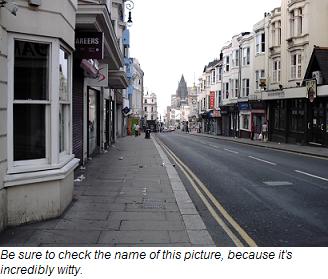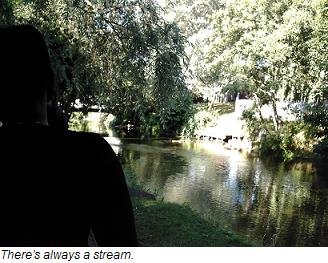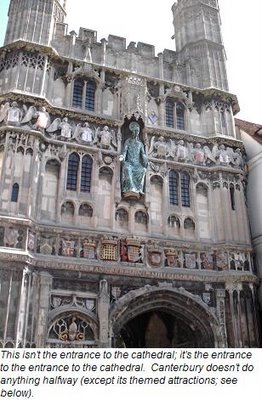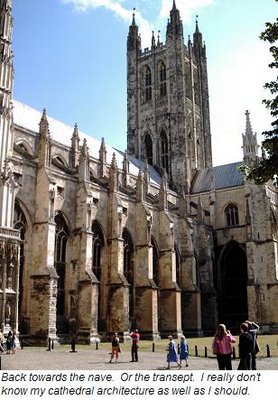Totally X-Treme Cathedral Mega-Weekend, Part Three: London
--Alan Partridge
I have to skip ahead in time a bit to comment on DCI this year, because I know you've been angrily muttering, "What did he think of Finals?" I only got to see shows over the Internet, streaming live from the regional in Atlanta and Semis in Madison, but from what I saw I'm pretty happy with how things turned out, especially Cavaliers winning and Bluecoats ending an amazing season in 4th (their highest finish ever). I wish Vanguard could'e finished higher, but there was no way they were going to top Cadets, as much as it might've seemed possible in Semis, and I'm split on Crown and Blue Knights. I guess a tie would've been a good cop-out there. The problem this year with wanting one corps to move up was not wanting the corps ahead of them to move down. I think that's the sign of a good season.
Sunday was the last of my three consecutive early mornings. Jed Ireland, whom some of you may know, emailed me to say that he and a friend would be passing through London on their way back from Prague, so we arranged to meet at Paddington Station for lunch and a quick visit. Jed and I have known each other since... what, second grade? Kindergarten is probable, but I think my first memories of him are from Mrs. Hedrick's class at Lupin Hill. He suggested we meet at 10:00. I would've liked it a little later, but they didn't have much time and I have all the time in the world, so 10:00 it was. I got up at 7:00 again, caught the train at Falmer at 8:00, and discovered upon my arrival at Brighton that I'd have to wait 45 minutes or so for the train to London. This had the potential to screw up all my plans. It did, however, give me a chance to walk around Brighton a bit on an early Sunday morning. Nothing was open, of course, but the quiet was nice.

I didn't end up getting to Paddington until about 10:20, but we'd anticipated some confusion (due to a modern reliance on the cell phone, which I don't have here) and after some cautious circling the three of us -- me, Jed, and Ryan -- met up. We headed up the street to a little cafe called Mimo, where I convinced Jed to get the full English.
They had a ton of stories about Prague, but ever since the Praguese stopped trading cars for blue jeans, I have to say the city has lost something of its luster for me (and the fact that it was the primary filming location for the D&D movie doesn't help). However, I'd also go there in a heartbeat if I could. I can contain paradoxes. I think my favorite story of theirs was about the time they ate dog meat, or were concerned they might've been eating it. That's Prague for you!
After our meal (nobody at the cafe, by the way, was actually English: our waitress was Polish, another table of patrons was French, and everyone else was... I dunno... European), we tried to make the best of our limited time by going to Hyde Park. There's a bit of a drought going on here, so Hyde Park isn't quite as green and lush as it ought to be. We were in Kensington Gardens, at the north end of the Serpentine. Historically speaking, Kensington Gardens is best known as the site of the Great Exhibition in 1851 (which I now know all about thanks to my Victorian class last session) and as a location in Peter Pan (ditto). Hyde Park itself, of course, is named after Edward Hyde, the fun-loving, psychopathic alter ego of Dr. Jekyll, in honor of his death while fighting invaders from Mars. We didn't make it far into the park before we had to head back, but at least we got lots of pictures.
By 12:30, though, they had to be back on their express train to Heathrow, so I accompanied them back to Paddington and saw them off. It was good to see Jed again, and to meet Ryan. Hopefully I can visit them in Washington soon.
After I left them behind, the Totally X-Treme Cathedral Mega-Weekend was back on.
Saint Paul's. Of course, I'd passed by here with Lori, Charles, and Raff, but we didn't get a closer look that day. The last time I was in England, four years ago, I attended a performance of Handel's "Messiah" here, and it was fantastic -- one of those all-things-aligned experiences. I was looking forward to going up into the cupola, but since it was a Sunday nearly everything was closed. On the plus side, admission was free, and there were hand-made flyers about a "danced memorial" for Hiroshima Day from 1:30 to 2:30, which sounded interesting, so I walked around a bit inside the cathedral until it started. Photography isn't allowed in the cathedral itself (although that didn't stop a few die-hards from disrespecting the cathedral anyway), but outisde, and beneath, in the crypt, yes.
By the time I'd made my lap the memorial was about to begin, so I settled down on the steps of the transept with an Apple Tango. Ah, Apple Tango. Not much of a crowd had gathered, but then again there didn't seem to be any publicity besides the flyers I'd seen taped to the gate. The dance itself was... modern. Very, very modern. "Dance" is probably too loose a term for it, actualy. There was movement, and impressive bodily control, and it certainly had expressive power. There was also music, but no real sense of time or rhythm. I suppose we really don't have another word for it but "dance."
The only gripe I had with the performance was a logistical one, but it was so distracting it made it difficult to really get into it. There's only one gate in or out of the grounds around St. Paul's, and the memorial was held right up against it. Moreover, there was absolutely no crowd control, which meant that this sort of thing was commonplace.
If you know me, you probably know this kind of thing irritates me to no end.
I took some video of the event, as well, but honestly, their movements were so slow and deliberate my 30-second clips look more or less like the photos. At one point, about half an hour in, they recruited a few confused students from the sparse audience, which led to the two of them ending back at their starting positions, at which time they repeated everything they'd just done, but this time with a rock on the big grey sheet. I was actually pretty proud of myself that I recognized it was the same dance, because really, it more or less looked like a series of painful, glacially slow movements in no particular order. Nonetheless, well done.
Afterwards, I went down into the crypt to visit the little priest's room and the giftshop, then up into the cathedral to take it all in for a bit.
Once outside, the bells started up, and they were so loud I had to record it. Click here to hear an mp3 of the bells of St. Paul's.
Once I left St. Paul's, I went on a brutal sightseeing spree, starting with Fleet Street.
I continue to be disappointed that Fleet Street, traditional home to one of my heroes, has no visible, public connection to Sweeney Todd. Why no barber shop called "Todd's" or something similar? Or a pie shop? Come on! Wouldn't you go there? I would. A barber shop next to a pie shop would clean up. Not only would do a ton of business, but tourists would flock to the place (if they marketed it correctly). I'd buy a T-shirt that said "I got cut at Sweeney Todd's" or "You are what you eat at Mrs. Lovett's Pie Shop" in a heartbeat.
But no. All that's there now is a bunch of non-Todd-related retail stores and the law courts.
I did, however, discover a little church designed by Sir Christopher Wren just down from St. Paul's that I'd never noticed before. Wren was a 17th-century architect who was instrumental in rebuilding London after the Great Fire of 1666. His churches are all over the place in the city. In fact, he designed St. Paul's, too, and was the first person to be buried there. My interest in him began with From Hell and its wacky ideas about Wren's hidden agenda. As for this church in particular, its oddly tiered steeple was the inspiration for the first tiered wedding cake. True story!There was also this pub, and I felt I had to take a picture of it, after having taken a class that was at least partially about Punch magazine. Wonder if Therie's been here -- she wrote her graduate thesis on Punch, if I recall correctly.
Further down is Temple Bar, where the law courts are. "Bar" here is a shortened form of "Barrier," and until the late 19th century there was a stone gate (designed by Wren, incidentally) that marked the dividing line between the City of London and Westminster. It's all very complicated.
Temple Bar is also the home of Robert Audley, the protagonist of Lady Audley's Secret. In the book, he's a lazy lawyer who's never actually had a case (this seems to have been a Victorian theme; there are two similar lawyers in Our Mutual Friend).
Across the street from the Courts is a bar, called the George, or the King George, I believe, which was frequented John Donne. It also has some rather odd decorations around the door.
From there, I made my way to the Thames. I didn't know where I was headed, but I kept walking anyway.
One thing I knew I wanted to see was Cleopatra's Needle. This obelisk was given by Egypt to Great Britain in 1819 to commemorate two military victories, but it stayed in Alexandria until 1877 when, after a series of disasters, it was finally brought to London. Alan Moore goes through the specific disasters in From Hell, which I found fascinating but can't recall now. Thanks to Wikipedia, I know that it was encased in a huge iron cylinder which was towed by a ship, but was lost in the Bay of Biscay during a storm, where it floated freely for a couple months. Altogether it's a brooding, magical, angry thing. I can only assume its twins in Paris and New York are equally brooding, magical, and angry (and I heard the one in Paris doesn't tip).
It's flanked by a pair of sphinxes, one of which was damaged during WWII.
Speaking of WWII, there's this cool WWII memorial right near the Needle. Specifically, it's a memorial to the Battle of Britain.
Once I'd gotten that far, I knew I was headed for the Aquarium, which isn't really an aquarium at all anymore. I'd seen a sign there when I'd been in London weeks ago on the river cruise, and I just had to confirm it said what I thought it said.
There's some other pretty weird stuff around there, too, like a Dali exhibition and perhaps the world's only Salvador Dali impersonator, as well as a Dali-inspired (or -created?) elephant statue.
(As an aside, whenever I see Dali I can't help but be reminded of a bit on SCTV where Salvador Dali had a "learning to paint" class on TV, a la Bob Ross. Hilarity ensued.)
The old Aquarium is a bunch of nonsense now. Essentially, it's one big Namco-owned arcade. I spent some time trying to out-dance a computer -- impossible -- and then killed zombies with a boy in care. No, I didn't do that. I just sat down.
After that, I crossed back over the Thames to see Westminster Abbey and the statues in Parliament Square, then went back to the Thames to get a good look at the statue of Queen Boadicea.
Yeah, about that Lincoln statue. My sources tell me it's a replica of a statue in Chicago. More than that, I really can't say.
Queen Boadicea ruled over a large tribe of Celts in the first century AD and led some major resistance against the Romans. She's probably best known for burning Londinium to the ground and killing as many as 80,000 Romans at a Roman city where St. Albans stands today. Yeah. She's pretty bad-ass.
By now I was starving and walked off my feet, despite a lot of sitting around doing not much of anything in Parliament Square, so I walked all the way back along the Thames until I came upon a little park near Embankment Station -- the exact name escapes me now -- where I could eat and relax. There were a bunch of deck chairs arranged before a stage, calling my name.
I tried reading, but I was just way too tired and had to call it -- i.e., consciousness -- quits. It was the end of a long, long day at the end of a long, long weekend.






